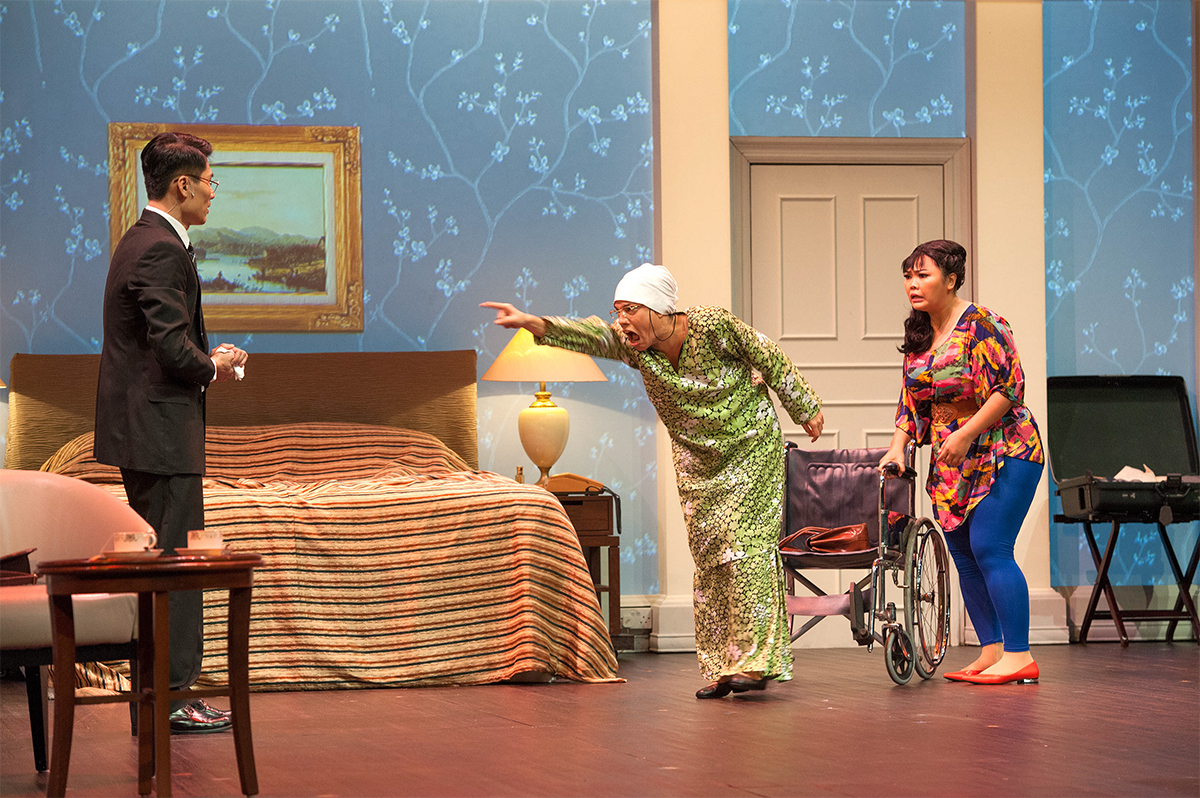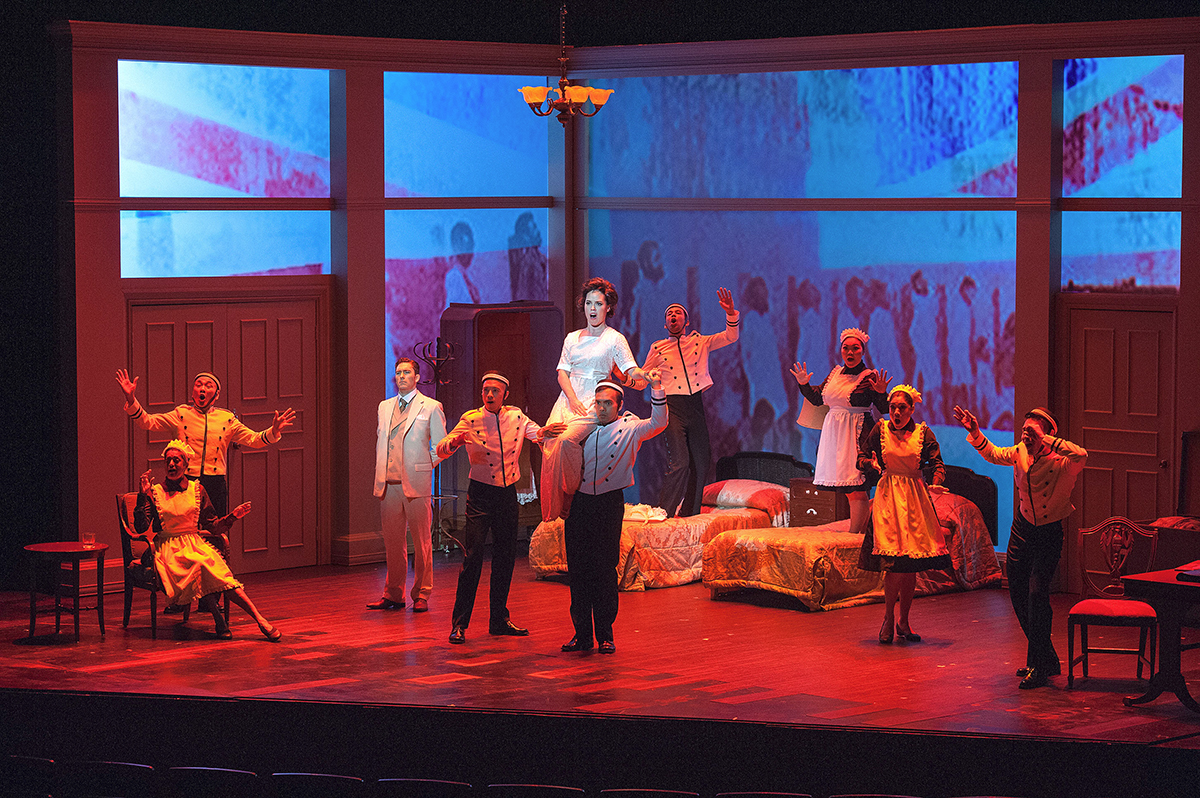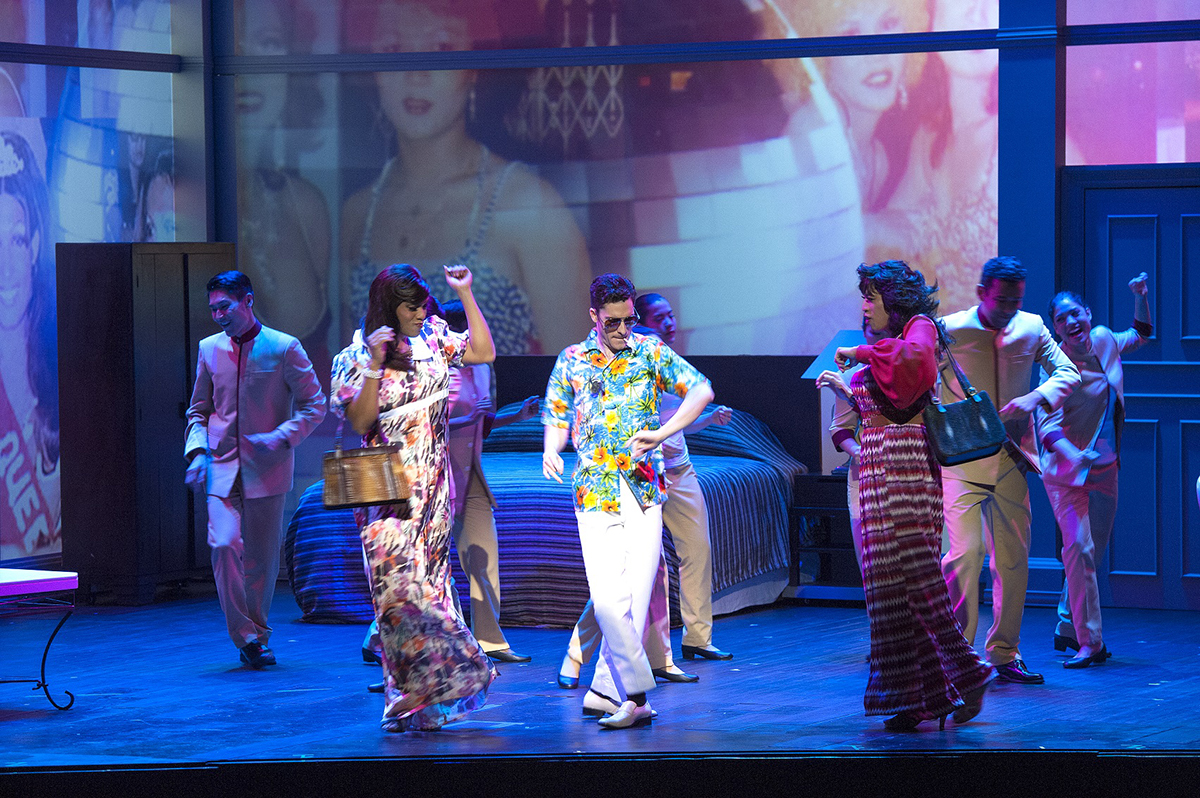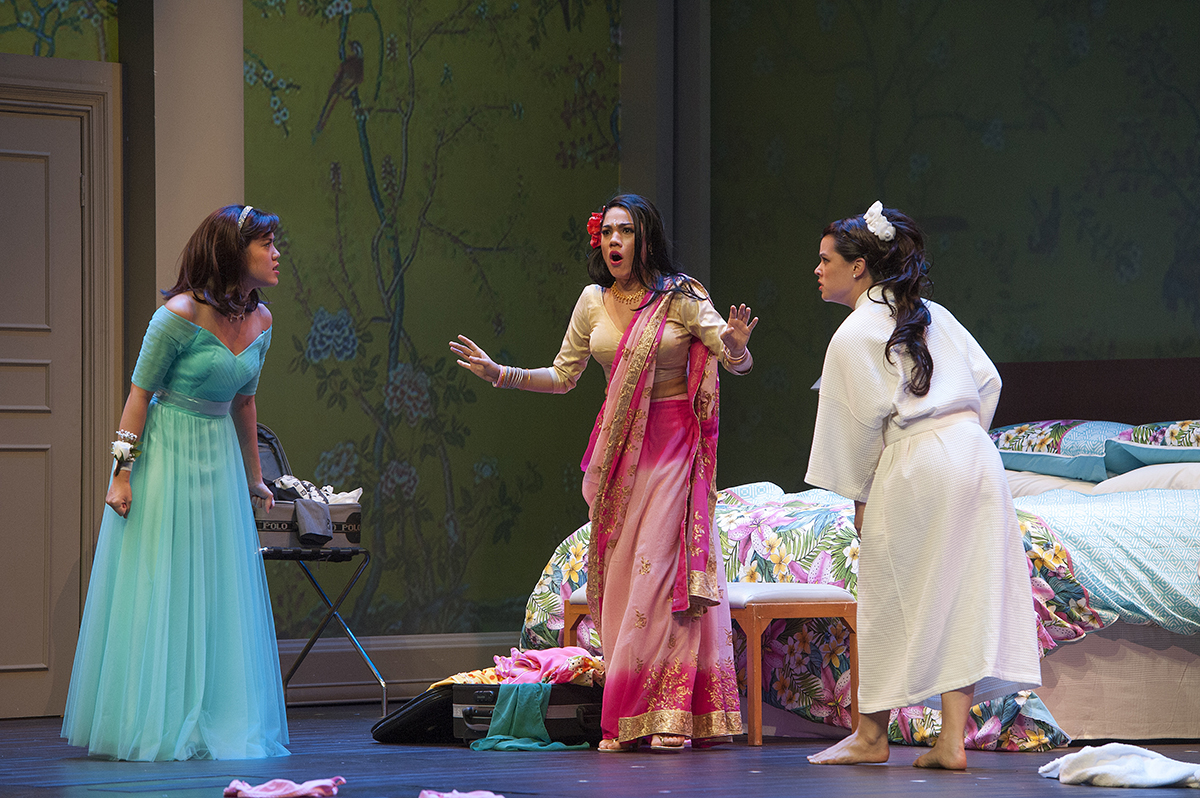
OzAsia: W!ld Rice Theatre, Hotel: Close to home
At the opening of W!ld Rice Theatre’s Hotel and from time to time between episodes, performers in black fill the stage as if citizens (singing “Rule Brittania” or Singapore’s national anthem), travellers (the nation state’s influx of diaspora) or hotel staff — unpacking their livery or practising routine tasks. Two walls and assortments of furniture draw in to complete a room with two entrances. Changing rear-projected wall-paper and costuming deftly signify eras, as do documentary photographs, film footage and other images, such as for The Good Manners Campaign accompanied by the singing of “Stand up for Singapore.” It’s a space cleverly designed for a close encounter with a culture unfamiliar to most Australians, but in many ways close to home.
Hotel comprises 11 plays, each around half an hour, each with a bracing sting in the tail, all linked by being set in one hotel room à la Raffles and unfolding over the course of 100 years in one nation state, Singapore, from British colonial rule to independence from Malaysia in 1965 and on to the present, and performed in two gripping two-and-a-half hour instalments.
An ensemble of 14 role-changing, sometimes gender-swapping performers virtuosically engage in situation comedy, wild farce, high drama and song and dance. What unites all of these apparently disparate components is an unremitting focus on Singaporean culture in terms of race, class, religion and gender, evoking at once rich diversity and unresolved tensions. What makes Hotel deeply fascinating is its dramatically rich account of the escalating complexity of Singapore’s racial and cultural diversity, unforgettably felt not least in the production’s last scene. But I’ll begin at the very beginning of Hotel and then jump to the end.

Hotel, W!LD RICE, photo courtesy the artists and OzAsia 2017
From first to last: the drama of diversity
In the first scene, in 1915, the Eurasian and devoutly Christian wife of a racist, sexist and bullying English planter is shocked when he delightedly insists they attend the public execution of some 50 Sepoys: Muslim Indian soldiers in the British army who had violently mutinied in protest at being sent to fight against Muslim Turkey. She defiantly refuses to attend, her husband departs, she communicates sympathetically in Malay with a Muslim bellboy who admits a desire to “kill every white face,” gives him a valuable necklace (a gift from her husband a short while before) and, deciding to leave her husband, exits for the Sepoy lines. Her act won’t upset the status quo but it indicates the depth of the tensions that will drive Hotel. Shots are heard, the cast sing “Land of hope and glory” at the end of a scene that commenced with “Rule Britannia.”
The scene plays out tensely, the wife reserved, consistently insulted for being a woman and of mixed race and then nervously frantic under pressure. But in her husband’s absence, a sense of resolve firms. It’s a surprisingly rapid but convincing release, in a scene already focused on power, class, gender and the ‘otherness’ of being Eurasian and, under British rule, Malay. That ‘otherness’ will play out across the hours in many permutations as will the role of language in throwing up barriers or allowing alternative expression.
While this might seem like a thematically complex beginning, compared with what’s to come it’s relatively simple if true to the way most scenes play out: a social binary will be met with a third element, either from within the pair, or from without, in a recurring dialectical dynamic.
In Hotel’s final scene, set in the present — if with an air of prophesy — an elderly man (Ivan Heng, one of Hotel’s two directors) and his wife have installed themselves in the hotel room, with a nurse, as long-term residents. Because he’s ill, management are not keen on having the hotel treated like a hospital. The scene is built around the seemingly well-to-do Singaporean Chinese couple’s resistance to being moved out. As pressure builds, what commenced as comedy — including the wife’s blunt sexual comments and her husband’s curmudgeonly casual racism towards his daughter’s Mauritian husband (who fights back) — turns ever so gradually dark. Under pressure from management, he reveals he’s dying of prostate cancer and asks to see the hotel staff whom he thanks and quizzes about their origins, revealing diversity beyond the anticipated Chinese, Malay and Indian mix and including two mainland Chinese workers who, to his surprise, speak no English. “What’s the need?”, is the response, an indication that Singapore is changing beyond the comprehension of a member of a cultural group that comprises 76% of the state’s population and whose first language is English.
Even the man’s economic standing has been undermined: he reveals that his and his wife’s properties have been sold out from under them by developers, that the couple have tried unsuccessfully to live with their adult children in Australia and returned home to enable him to die in peace and comfort in a hotel room. This revelation tempers our dislike for the man and we’re amused by his allowing the staff to take selfies with him and shake his hand, but it’s his words to them about “home” that cut deep and shift the play’s mood into sadness. Asked why he decided to spend his last days in a hotel room, he says, underlining the many different periods and states of being in Hotel, that the room is “a temporary space” and that “home” is “all an illusion.” He feels, in effect, that his kind are on their way, sooner or later, to becoming the ‘others’ he has mocked. This final scene — typically compact, linguistically sharp and deft at briskly changing the emotional temperature — tautly draws together the thematic threads of Hotel’s rich weave. It acknowledges a persistent preoccupation, as one character in this scene puts it: “We don’t even know what to do with diversity,” while revealing an already arriving future of even greater diversity, something in an era of globalisation we can all recognise, but more overtly experienced in a small nation state. The one connection to the past is a benign Indian woman who has worked at the hotel for 30 years and assures management that, yes, other people have died in the hotel over the decades.
Issues and eras
The nine scenes between the first and the last accommodate a vast range of characters, historical events and issues. In a comic scene set in the 20s, a housemaid, caught out in a hotel guest’s dress, is confronted by a nun and two policemen, little knowing that she’s adopted the role of a woman who has beaten her fellow maid and that the nun, in response to new legislation forbidding the abuse of maids, is following up on a reported crime. In 1935, a scene is built around a spiritualist who anticipates a coming war in the face of British indifference; in 1955, a famous filmmaker, P Ramlee, battles to make a socially conscious film without singing and dancing and focused on Malay culture.
In 1975, in an hilarious drug-fuelled farce (the wallpaper warps) a Eurasian transgender person, Brigid, is confronted with the Virgin Mary, giant walking penises and angels arguing for commitment to one gender or another. It’s revealed that the first sex reassignment operation in Singapore took place in 1971 and that by 1973 identity cards reflected the transition. But Brigid declares love for both her/his breasts and cock and is determined to be a different kind of ‘other.’ This passion is juxtaposed with the sudden appearance from a wardrobe — at the mention of God — of the nation’s founding Prime Minister Lee Kuan Yew, railing against men with long hair spoiling foreign investment in Singapore and opposing ambiguity in general. Brigid and the US Viet Vet who provided the drugs have sex, she mounts him, and in a segue we see them celebrating marriage.

Hotel, W!LD RICE, photo courtesy the artists and OzAsia 2017
Across generations: continuity & disruption
Occasionally, characters in one scene reappear in a later one. The perky aspiring film starlet of 1955 reappears, now devoutly Muslim, in 2005, travelling with her businessman son from Malaya, but Singapore is not what it used to be. Worse, post 9/11, her angry son is an easy target for over-zealous security forces and is arrested. Her grandson comments that although his father has no bomb, “the bomb is in the minds” of the Singaporeans. This was the one scene, that although painfully tense, lacked the telling extra dimension common to the others.
In 1945, a Japanese captain, Matsuda, is told by his senior officer that the army is leaving Singapore and that he can bring his son with him, but not his non-Japanese wife Sharifah. The separation is brutally painful, especially when we learn that Matsuda, in act of unexpected kindness, had rescued her from working in a “comfort station,” where women were forced into sexually serving Japanese soldiers. Her anger is unforgiving. In 1985, in Hotel’s most moving and emotionally complex scene, the son, Natsuo, nervous to the point of vomiting and struggling to practice his limited English, has returned to Singapore to meet his unsuspecting mother, now considerably aged and confined to a wheelchair and assisted by her English-speaking grand-daughter who translates for her into Malay. The barriers to communication are many, until Sharifah in anger, leaps up from her wheelchair and yells “Inu!” (dog) at Natsuo, and then a string of other words in Japanese that she explains, “feel like blood in my mouth.” He’s profoundly shocked, falling back as if hit, but persists, offering a recording of his father, who “wanted to come back,” singing for her. In a wrenching exchange Sharifah declares this will be their only meeting and, as he bows low before her, acknowledges him as her son, though she cannot forgive her husband. The full weight of the impacts of war and racism are conveyed in nuanced performances of awkwardness, stuttering hesitancy, misunderstanding, unleashed pain and provisional conciliation.
Another scene, set in 1995, plays out as a classic wedding farce awash with complications around Chinese and Indian intermarriage which, if difficult enough in themselves, are exacerbated by the Chinese bride’s decision to wear a sari for the second stage of the ceremony, to the unyielding resistance of her mother who walks out on the event, just when you expect accommodation. It’s a chilling end to an otherwise riot of contrasting characters — an overly accommodating Indian aunt, a stereotypical gay makeup artist, a sniping Chinese sister of the bride, the wearied father of the bride, an indifferent groom and his understanding mother who comments wryly to her Chinese counterpart, “Yes, the sari is a little too Indian.”

Hotel, W!LD RICE, photo courtesy the artists and OzAsia 2017
Close to home
In many respects, Hotel offers a conventional theatre experience, but provides evidence aplenty that with ambition and vision there is still life in an often tired model. With its two writers, two directors and 11 substantial episodes it’s akin to contemporary television series with their heightened creative teamwork and their appeal to sustained audience engagement. The OzAsia Festival audience met Hotel and its talented cast with unbridled enthusiasm, including the local Singaporean diaspora, some of whom were heard singing along with the national anthem and others, too long away from home, rumoured to have been surprised that the production could get away with the God/Lee Kuan Yew moment.
Although Hotel might not have addressed continuing constraints on democracy, including on the arts (read an interview with leading theatremaker and Director of the Singapore Festival 2014-17 Ong Keng Sen), it was nonetheless disarmingly frank on key matters and admirably culturally self-critical. As our own country increasingly inclines to authoritarianism and struggles to deal with expanded multiculturalism, Hotel’s Singapore feels close to home. OzAsia Festival Artistic Director Joseph Mitchell’s decision to program was bold, apt and timely.
–
OzAsia Festival: W!ld Rice Theatre, Hotel, writers Alfian Sa’at, Marcia Vanderstraaten, directors Ivan Heng, Glen Goei, set designer Wong Chee Wai, lighting designer Lim Woan Wen, multimedia designer Brian Gothong Tan, composer, sound designer Paul Searles, The Gunnery, costume designer Theresa Chan; Dunstan Playhouse, Adelaide, 28-30 Sept
Top image credit: Hotel, W!LD RICE, photo courtesy the artists and OzAsia 2017






